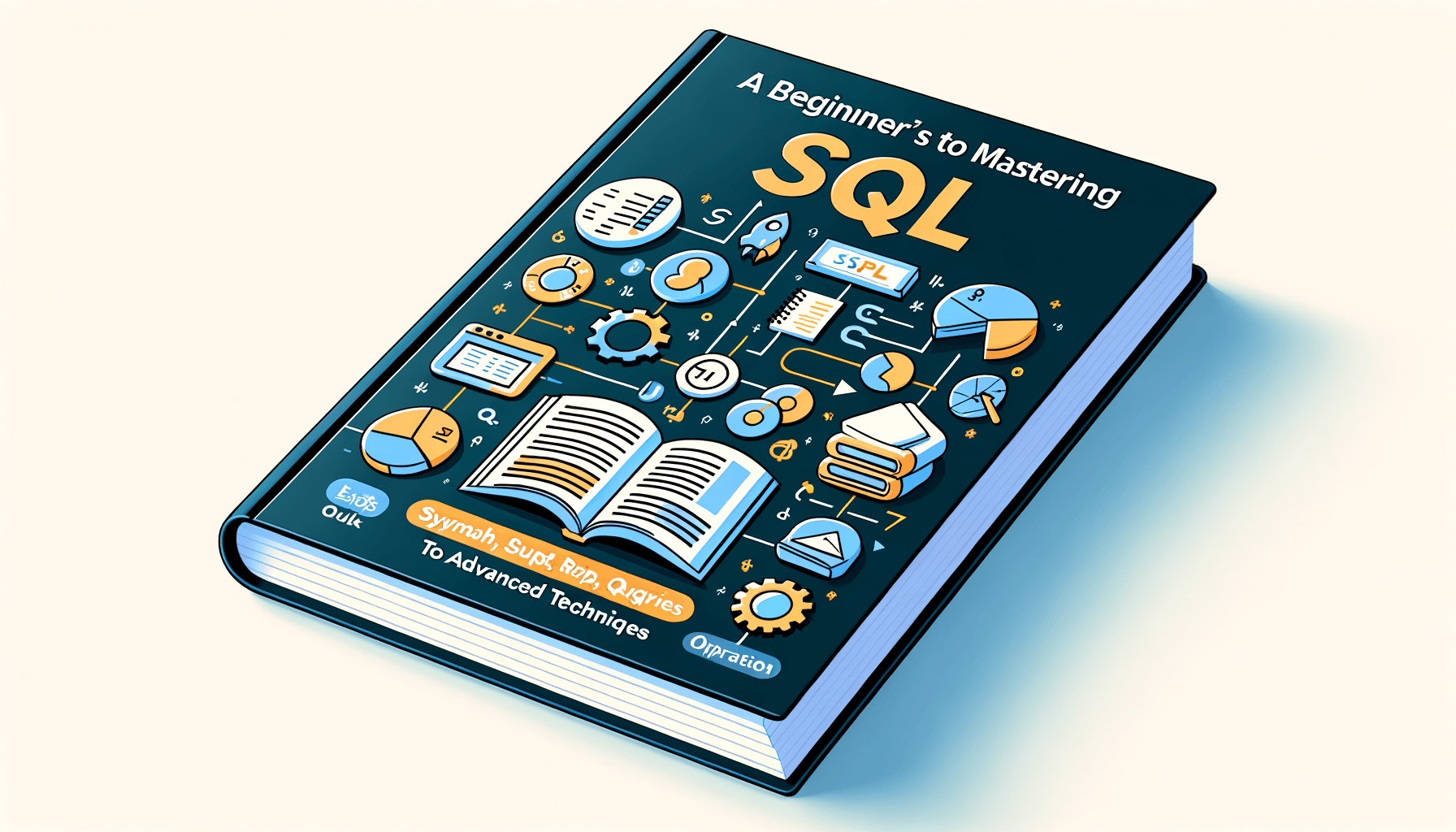A big variety of articles and resources

Master SQL Data Analysis: A Comprehensive Guide to Acquiring In-Demand Skills
 Sia Author and Instructor
Learn SQL
Sia Author and Instructor
Learn SQL
15 minute read
SQL, or Structured Query Language, is the backbone of data analysis. It's a must-have skill for anyone looking to work with data, whether you're an analyst, engineer, or scientist. This guide will walk you through the essential SQL skills needed to navigate the complexities of data ecosystems. From basic queries to advanced techniques, you'll learn how to make data-driven decisions and uncover hidden patterns in your data.
Key Takeaways
- SQL is essential for anyone working with data, from analysts to engineers.
- Mastering basic SQL queries like SELECT and JOIN is crucial for data analysis.
- Advanced SQL techniques, such as window functions and statistical analysis, can uncover hidden data patterns.
- Optimizing SQL queries can significantly improve performance and efficiency.
- Integrating SQL with other tools like Python and Excel enhances its power and versatility.
Understanding the Importance of SQL in Data Analysis
Why SQL is Essential for Data Analysts
SQL (Structured Query Language) is a fundamental tool for data analysts. Mastering SQL allows analysts to efficiently manage, manipulate, and analyze relational databases. With just a few basic commands, you can handle most of your daily data tasks. This makes SQL an indispensable skill in the data analysis toolkit.
The Role of SQL in Modern Data Ecosystems
In today's data-driven world, SQL plays a crucial role in modern data ecosystems. It provides the tools to organize messy datasets, isolate key metrics, and prepare data for visualization and modeling. SQL's ability to integrate with other data tools, like Python and Excel, further enhances its importance in data analysis.
Comparing SQL with Other Data Analysis Tools
While there are many data analysis tools available, SQL stands out for its simplicity and efficiency. Unlike other tools that may require extensive coding knowledge, SQL's straightforward syntax makes it accessible to beginners. Additionally, SQL's powerful querying capabilities allow for precise data selection and filtering, making it a preferred choice for many data analysts.
Mastering Basic SQL Queries
SELECT Statements and Filtering Data
Learning to write SELECT statements is the first step in mastering SQL. This involves specifying the columns you want to retrieve and the table from which to get them. Filtering data is equally important, and you can do this using the WHERE clause to get only the rows that meet certain conditions.
Sorting and Limiting Results
Sorting data helps in organizing your query results meaningfully. You can use the ORDER BY clause to sort data by one or more columns, either in ascending (ASC) or descending (DESC) order. Limiting results is also crucial, especially when dealing with large datasets. The LIMIT clause allows you to specify the number of rows you want to retrieve.
Combining Data with JOINs
JOINs are essential for combining data from multiple tables. The most common types are INNER JOIN, LEFT JOIN, RIGHT JOIN, and FULL OUTER JOIN. Each type serves a different purpose, but they all help in creating a more comprehensive dataset by linking related data from different tables.
Advanced SQL Techniques for Data Analysis
Window Functions for Advanced Analytics
Window functions are essential for advanced analytics in SQL. They allow you to perform calculations across a set of table rows related to the current row. This is useful for tasks like calculating moving averages and percentiles. Mastering window functions like ROW_NUMBER() and RANK() can significantly enhance your data analysis capabilities.
Using GROUPING SETS and CUBE for Aggregations
GROUPING SETS and CUBE are powerful tools for creating multi-level data summaries. They enable you to generate complex aggregations with ease. By using these functions, you can uncover hidden patterns in your data and make more informed decisions.
Statistical Analysis with SQL
SQL is not just for querying data; it can also be used for statistical analysis. You can perform hypothesis testing and regression analysis directly within SQL. This allows you to uncover hidden data patterns and make data-driven decisions.
Advanced SQL skills make it easier to work with complex databases, helping you find and use data more effectively. These skills help professionals to efficiently manipulate and analyze complex data structures, unlocking the full potential of relational databases for informed decision-making and strategic insights.
Optimizing SQL Queries for Performance
Indexing Strategies
Proficiency in indexing is key to optimizing SQL performance. Intermediate users should have a grasp of composite indexes, which involve multiple columns, and their strategic application in optimizing queries with complex filtering criteria. Additionally, they should be attentive to index maintenance, ensuring regular updates and monitoring for index fragmentation to sustain query performance over time. Furthermore, understanding query optimization, including analyzing query execution plans to make informed decisions on index usage, is essential for achieving efficient database operations.
Query Optimization Techniques
Performance Tuning: Proficiency in SQL performance tuning is crucial for ensuring database efficiency. This skill encompasses various aspects, including query optimization, where developers craft queries that exploit indexes, use JOINs effectively, and adhere to database-specific optimization techniques. Additionally, mastering indexing strategies is essential, involving the judicious use of clustered, non-clustered, and full-text indexes while addressing index fragmentation. Regularly monitoring query performance, identifying bottlenecks, and leveraging profiling tools for query execution plan analysis is integral to this skill. Furthermore, a deep understanding of database design choices, such as normalization, denormalization, and boost query performance when necessary. Effective data modeling is essential, including creating tables, defining relationships, and enforcing constraints. This encompasses a solid understanding of primary, foreign, and indexes and their roles in maintaining data integrity and optimizing query performance. Additionally, developers should be skilled in performance tuning techniques, including indexing strategies and query optimization, to create efficient database schemas.
Understanding Execution Plans
Adhere to database-specific optimization techniques. Additionally, mastering indexing strategies is essential, involving the judicious use of clustered, non-clustered, and full-text indexes while addressing index fragmentation. Regularly monitoring query performance, identifying bottlenecks, and leveraging profiling tools for query execution plan analysis is integral to this skill. Furthermore, a deep understanding of database design choices, such as normalization, denormalization, and boost query performance when necessary. Effective data modeling is essential, including creating tables, defining relationships, and enforcing constraints. This encompasses a solid understanding of primary, foreign, and indexes and their roles in maintaining data integrity and optimizing query performance. Additionally, developers should be skilled in performance tuning techniques, including indexing strategies and query optimization, to create efficient database schemas.
Integrating SQL with Other Data Tools
SQL and Python: A Powerful Combination
SQL and Python together form a powerful duo for data analysis. Python's versatility and SQL's efficiency in handling databases make them a perfect match. You can use SQL to query and manipulate data, then leverage Python's libraries like Pandas and NumPy for further analysis. This combination allows for seamless data workflows, from extraction to advanced analytics.
Using SQL with Excel for Data Analysis
Excel is a widely-used tool for data analysis, and integrating it with SQL can enhance its capabilities. By connecting SQL databases to Excel, you can pull in large datasets and use Excel's features for further analysis. This integration is particularly useful for those who are comfortable with Excel but need the power of SQL for more complex queries.
Connecting SQL to Data Visualization Tools
Integrating SQL with Business Intelligence (BI) tools like Tableau, Power BI, or QlikView is a critical step in unleashing the full potential of your data for effective data visualization, analysis, and decision-making. SQL (Structured Query Language) is a powerful bridge between your databases and these BI tools, allowing you to extract, transform, and load (ETL) data and create interactive and insightful visualizations.
Combining SQL queries with data visualization tools enables analysts to build dynamic dashboards that allow stakeholders to explore and interact with data meaningfully. This integration is essential for storytelling with data, where SQL-driven insights are presented in an engaging and understandable way.
Building and Managing Databases
Designing Efficient Database Schemas
Designing a database schema is a critical skill for any SQL developer. It's not just about writing queries; it's about understanding the principles of database design. This includes knowing how to normalize data to reduce redundancy and ensure data integrity. However, it's also important to know when to denormalize data to boost query performance. Effective data modeling involves creating tables, defining relationships, and enforcing constraints.
Data Modeling Best Practices
Effective data modeling is essential for creating efficient database schemas. This includes creating tables, defining relationships, and enforcing constraints. A solid understanding of primary keys, foreign keys, and indexes is crucial for maintaining data integrity and optimizing query performance. Additionally, developers should be skilled in performance tuning techniques, including indexing strategies and query optimization.
Maintaining Data Integrity
Maintaining data integrity is vital for any database. This involves ensuring that the data is accurate and consistent over its entire lifecycle. Techniques for maintaining data integrity include using primary and foreign keys, enforcing constraints, and implementing robust error handling. Regularly monitoring query performance and identifying bottlenecks is also important for maintaining a healthy database.
Unlocking the power of data: a guide to effective analytics and database management. The synergy between data analytics and database management is crucial for strategic growth.
Real-World Applications of SQL in Data Analysis
Case Studies in Business Analytics
SQL is a powerful tool in business analytics, enabling companies to make data-driven decisions. By using SQL, businesses can analyze sales data, customer behavior, and market trends. This helps in identifying opportunities and optimizing strategies. SQL's ability to handle large datasets makes it indispensable for business intelligence.
SQL for Financial Data Analysis
In the financial sector, SQL is used to manage and analyze vast amounts of transactional data. Financial analysts rely on SQL to track and predict market trends, assess risks, and ensure compliance with regulations. The precision and efficiency of SQL queries are crucial for accurate financial reporting and analysis.
Healthcare Data Analysis with SQL
Healthcare organizations use SQL to manage patient records, track treatment outcomes, and conduct research. SQL helps in unlocking the power of data by providing insights into patient care and operational efficiency. This leads to improved patient outcomes and streamlined healthcare services.
SQL's versatility extends to various industries, making it a vital skill for data analysts. Whether in business, finance, or healthcare, SQL enables professionals to unlock valuable insights from data.
Developing a Data Analyst Portfolio with SQL Projects
Creating a portfolio of SQL projects is essential for showcasing your skills to potential employers. A well-crafted portfolio can set you apart in the competitive job market. Here are some tips to help you build an impressive portfolio.
Choosing the Right Projects
Selecting the right projects is crucial. Focus on projects that demonstrate a range of skills, from basic SQL queries to advanced data analysis techniques. Include projects that solve real-world problems, as this will show your ability to apply your knowledge in practical scenarios.
Showcasing Your SQL Skills
When presenting your projects, highlight the specific SQL skills you used. This could include data cleaning, data visualization, or complex query optimization. Make sure to explain the problem you were solving and how your SQL skills helped achieve the solution.
Building a Professional Portfolio
A professional portfolio should be well-organized and easy to navigate. Use a platform like GitHub to host your projects and include detailed documentation for each one. This will make it easier for potential employers to understand your work and the skills you bring to the table.
Remember, your portfolio is a reflection of your abilities. Take the time to ensure it is polished and professional.
By following these tips, you can create a portfolio that effectively showcases your SQL skills and helps you stand out to employers.
Learning Resources and Next Steps
Top SQL Courses and Certifications
Choosing the right learning pathway is like picking the right tools for a journey. Whether you prefer the structured environment of formal education, the flexibility of online courses and bootcamps, or the self-directed exploration of self-study, each path offers unique advantages. Weigh their benefits against your personal learning style, goals, and constraints to choose the best one.
Books and Online Resources
Building a solid foundation in SQL requires access to quality resources. Here are some recommended books and online materials:
- SQL for Dummies by Allen G. Taylor
- Learning SQL by Alan Beaulieu
- Online tutorials on platforms like W3Schools and Codecademy
Joining SQL and Data Analysis Communities
Engaging with a community can significantly enhance your learning experience. Consider joining forums, attending meetups, or participating in online groups. These communities often provide valuable insights, support, and networking opportunities.
Tip: Being part of a community can help you stay motivated and keep up with the latest trends in SQL and data analysis.
Soft Skills for Data Analysts
Data analysts must be able to explain their findings clearly. Good communication helps in sharing insights with team members and stakeholders. This skill ensures that everyone understands the data's story.
Understanding the business side is crucial for data analysts. It helps in making data-driven decisions that align with business goals. Business acumen allows analysts to see the bigger picture and understand how their work impacts the organization.
Data analysts often face complex problems. Being creative and having strong problem-solving skills can help in finding unique solutions. These skills are essential for overcoming challenges and making sense of complicated data sets.
Developing these soft skills can set great data analysts apart from good ones. They are just as important as technical skills in ensuring success in the field.
Introduction to Machine Learning with SQL
Basic Concepts of Machine Learning
Machine learning (ML) is a field of computer science that uses algorithms to find patterns in data and make predictions. Understanding these basics is crucial for integrating ML with SQL. SQL helps in querying and preparing data, which is the first step in any ML project.
Integrating SQL with Machine Learning Models
SQL can be combined with machine learning libraries like Python's sci-kit-learn or TensorFlow. This integration allows for developing predictive models and classification algorithms. Leveraging AI for enhanced MySQL performance management is a key benefit. You can use SQL to clean and preprocess data, making it ready for ML pipelines.
Practical Examples and Use Cases
There are many practical applications of SQL and ML integration. For instance, AI and SQL integration for predictive modeling and performance monitoring can help businesses forecast sales or detect fraud. Enhancing MySQL security with AI-driven measures is another example. These use cases show the power of combining SQL with machine learning.
Machine Learning with SQL is an exciting field that combines the power of data analysis with the simplicity of SQL queries. If you're eager to dive into this fascinating subject, our website offers a range of courses designed just for you. From beginner to advanced levels, we have something for everyone. Don't miss out on the opportunity to enhance your skills and advance your career. Visit our website today to explore our course catalog and find the perfect course for you!
Conclusion
Mastering SQL for data analysis opens up a world of opportunities in today's data-driven landscape. By honing essential skills like advanced analytics, effective communication, and business acumen, you can navigate the complexities of data with confidence. Whether you're just starting out or looking to enhance your expertise, this guide provides the foundational knowledge and practical tips needed to excel. Embrace the journey of continuous learning and hands-on practice, and you'll be well on your way to becoming a proficient data analyst, ready to tackle any data challenge that comes your way.
Frequently Asked Questions
What is SQL and why is it important for data analysis?
SQL stands for Structured Query Language. It's used to communicate with databases and is essential for data analysts because it helps them retrieve, manipulate, and analyze data efficiently.
How does SQL compare to other data analysis tools?
SQL is specifically designed for managing and querying relational databases. Unlike Excel or Python, SQL can handle large datasets more efficiently and is often faster for complex queries.
What are some basic SQL queries I should learn first?
You should start with SELECT statements to retrieve data, WHERE clauses to filter results, and JOIN operations to combine data from different tables.
What are advanced SQL techniques useful for data analysis?
Advanced techniques include window functions for complex calculations, GROUPING SETS and CUBE for multi-level aggregations, and statistical analysis for deeper insights.
How can I optimize SQL queries for better performance?
You can use indexing strategies, query optimization techniques, and understand execution plans to make your SQL queries run faster and more efficiently.
Can SQL be integrated with other tools for data analysis?
Yes, SQL can be easily integrated with tools like Python, Excel, and data visualization software to enhance your data analysis capabilities.
What are some real-world applications of SQL in data analysis?
SQL is used in various fields like business analytics, financial data analysis, and healthcare to make data-driven decisions and uncover insights.
How can I build a portfolio to showcase my SQL skills?
Choose relevant projects, document your work, and create a professional portfolio that highlights your SQL skills and accomplishments.
Related Articles

Learn SQL the Easy Way: A Beginner's Guide
10 minute read

Master SQL with Engaging Learn SQL Videos
10 minute read

Mastering Basic SQL Queries for Your Next Interview
9 minute read


